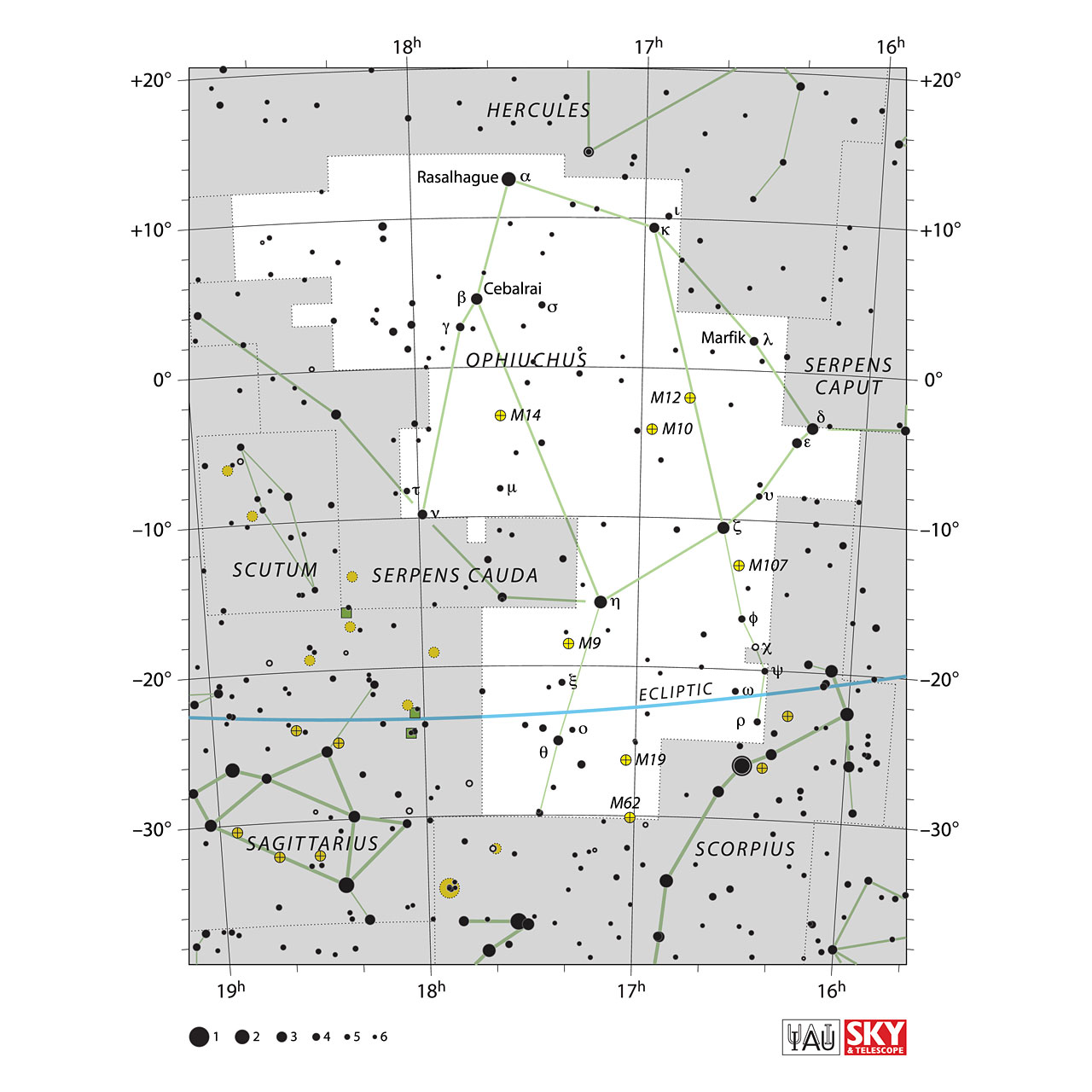Ophiuchus



Ophiuchus is a large equatorial constellation which appears highest in the midnight sky in the months around June. Ophiuchus was one of the 48 constellations listed by the 2nd-century astronomer Ptolemy.
It lies just north of the Milky Way and encompasses a particularly rich part of the galaxy. Our sightline towards the center of the galaxy lies not far away, in the neighboring constellation of Sagittarius.
This means that Ophiuchus is exceptionally rich in globular clusters, which mostly lie in spherical swarm around the galaxy’s center. Ophiuchus alone contains no fewer than 16 that are brighter than tenth magnitude, second only to Sagittarius which contains 18 clusters of the same brightness.
Although Ophiuchus is not among the twelve traditional constellations of the zodiac, the Sun passes through its southern extremities for around two weeks each year in early December. Ophiuchus is the only constellation other than the traditional twelve that the Sun passes through, making it effectively a thirteenth zodiacal constellation.
On sky charts, Ophiuchus is depicted as a man holding a serpent, often identified as Asclepius, the god of medicine. The figure’s brightest star is named Rasalhague, Arabic for ‘the head of the serpent collector’.
To the ancient Greeks, the constellation represented the god Apollo struggling with a huge snake that guarded the Oracle of Delphi. Later myths identified Ophiuchus with Laocoön, the Trojan priest of Poseidon, who warned his fellow Trojans about the Trojan Horse and was later slain by a pair of sea serpents sent by the gods to punish him.
In Babylonian astronomy, a “Sitting Gods” constellation seems to have been located in the general area of Ophiuchus. It is proposed that Ophiuchus may in fact be remotely descended from this Babylonian constellation, representing Nirah, a serpent-god who was sometimes depicted with his upper half human but with serpents for legs.
Although not one of the 12 Zodiac constellations, Ophiuchus is represented by the symbol ⛎.
In the Indian system Ophiuchus is called ಉರಗಧರ (Uragadhara)
Ophiuchus contains:
-
Stars
- Rasalhague (mag 2.1)
- Sabik (mag 2.4)
- ζ-Oph (mag 2.6)
- Yed Prior (mag 2.7)
- Cebalrai (mag 2.8)
- κ-Oph (mag 3.2)
- Yed Posterior (mag 3.2)
- θ-Oph (mag 3.3)
- ν-Oph (mag 3.3)
- 72-Oph (mag 3.7)
- γ-Oph (mag 3.7)
- 67-Oph (mag 4.0)
- p-Oph (mag 4.1)
- Marfik (mag 4.1)
- b-Oph (mag 4.2)
- χ-Oph (mag 4.3)
- d-Oph (mag 4.3)
- φ-Oph (mag 4.3)
- A-Oph (mag 4.3)
- σ-Oph (mag 4.3)
- ι-Oph (mag 4.4)
- ξ-Oph (mag 4.4)
- 68-Oph (mag 4.4)
- ω-Oph (mag 4.4)
- ψ-Oph (mag 4.5)
-
Open Clusters
-
Globular Clusters
- Messier 12 (mag 6.1)
- Messier 62 (mag 6.4)
- Messier 10 (mag 6.6)
- Messier 19 (mag 6.8)
- Messier 14 (mag 7.6)
- Messier 107 (mag 7.8)
- Messier 9 (mag 7.8)
- NGC 6356 (mag 8.2)
- NGC 6304 (mag 8.3)
- NGC 6293 (mag 8.3)
- NGC 6355 (mag 8.6)
- NGC 6284 (mag 8.9)
- NGC 6235 (mag 8.9)
- NGC 6316 (mag 9.0)
- NGC 6287 (mag 9.3)
- NGC 6366 (mag 9.5)
- NGC 6342 (mag 10.0)
- NGC 6517 (mag 10.3)
- NGC 6325 (mag 10.7)
- NGC 6401 (mag 10.7)
- NGC 6426 (mag 10.9)
- IC 1257
-
Galaxy
- NGC 6384 (mag 10.6)
- NGC 6570 (mag 13.2)
- NGC 6240 (mag 13.4)
- NGC 6509 (mag 13.4)
- NGC 6368 (mag 13.7)
- IC 1255 (mag 14.2)
- NGC 6296 (mag 14.2)
- IC 4688 (mag 14.7)
- NGC 6615 (mag 14.8)
- IC 1242 (mag 14.9)
- NGC 6378 (mag 15.1)
- NGC 6234 (mag 15.3)
- IC 4691 (mag 15.5)
- NGC 6280 (mag 15.5)
- NGC 6220 (mag 15.5)
- IC 4676 (mag 15.6)
View Ophiuchus in 3D 
Source: Wikipedia, in-the-sky.org
Image Courtesy: Sky&Telescope & IAU, Illustration Images linked from Urania's Mirror on Wikmedia Commons by Sidney Hall
Image Courtesy: Sky&Telescope & IAU, Illustration Images linked from Urania's Mirror on Wikmedia Commons by Sidney Hall
